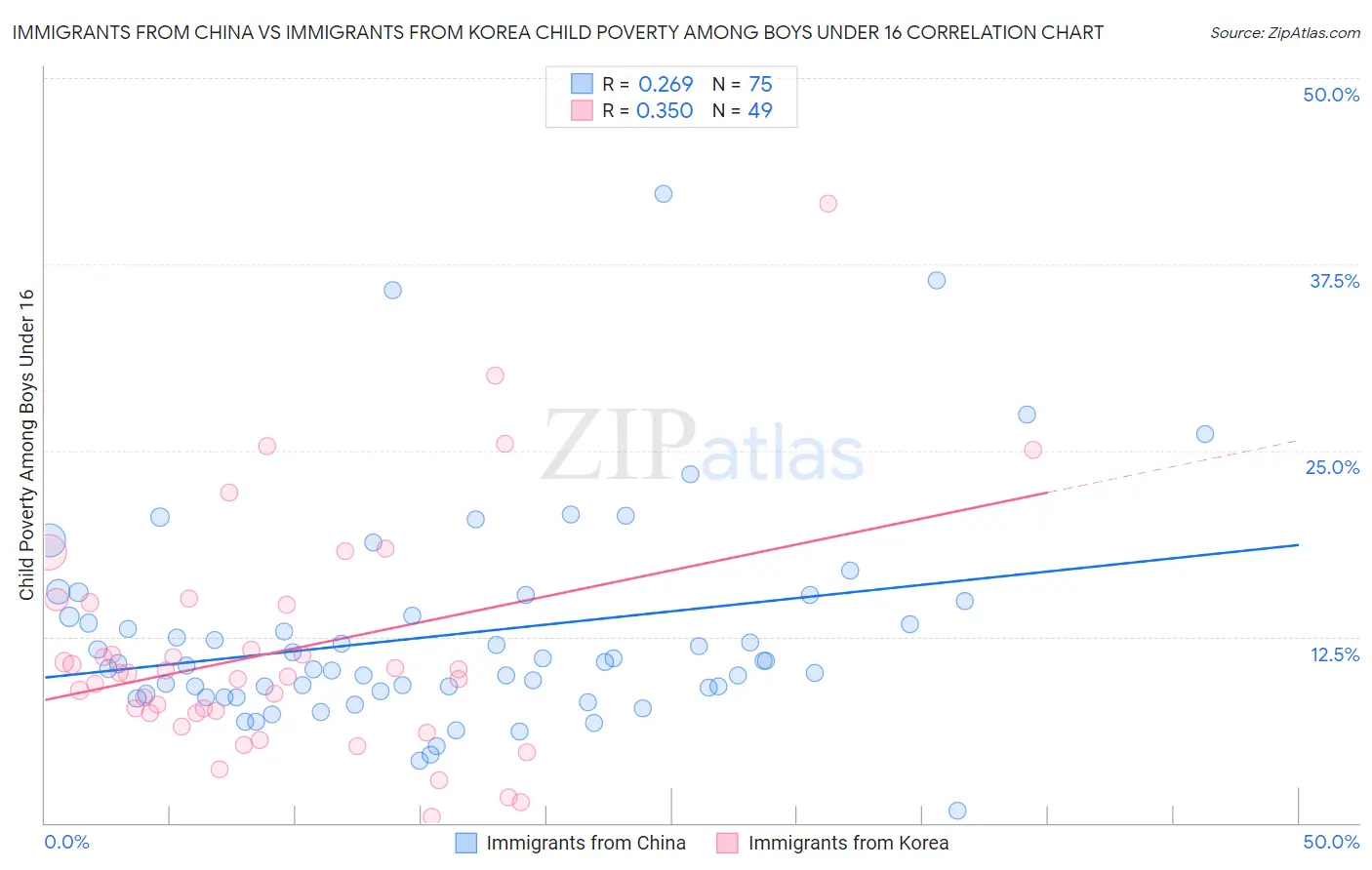Immigrants from China vs Immigrants from Korea Child Poverty Among Boys Under 16
COMPARE
Immigrants from China
Immigrants from Korea
Child Poverty Among Boys Under 16
Child Poverty Among Boys Under 16 Comparison
Immigrants from China
Immigrants from Korea
13.6%
CHILD POVERTY AMONG BOYS UNDER 16
99.8/ 100
METRIC RATING
32nd/ 347
METRIC RANK
13.0%
CHILD POVERTY AMONG BOYS UNDER 16
99.9/ 100
METRIC RATING
13th/ 347
METRIC RANK
Immigrants from China vs Immigrants from Korea Child Poverty Among Boys Under 16 Correlation Chart
The statistical analysis conducted on geographies consisting of 446,614,379 people shows a weak positive correlation between the proportion of Immigrants from China and poverty level among boys under the age of 16 in the United States with a correlation coefficient (R) of 0.269 and weighted average of 13.6%. Similarly, the statistical analysis conducted on geographies consisting of 408,025,168 people shows a mild positive correlation between the proportion of Immigrants from Korea and poverty level among boys under the age of 16 in the United States with a correlation coefficient (R) of 0.350 and weighted average of 13.0%, a difference of 4.3%.

Child Poverty Among Boys Under 16 Correlation Summary
| Measurement | Immigrants from China | Immigrants from Korea |
| Minimum | 0.83% | 0.39% |
| Maximum | 42.3% | 41.5% |
| Range | 41.4% | 41.1% |
| Mean | 12.6% | 11.6% |
| Median | 10.7% | 10.0% |
| Interquartile 25% (IQ1) | 8.6% | 7.4% |
| Interquartile 75% (IQ3) | 13.9% | 14.7% |
| Interquartile Range (IQR) | 5.3% | 7.3% |
| Standard Deviation (Sample) | 7.2% | 7.8% |
| Standard Deviation (Population) | 7.1% | 7.7% |
Demographics Similar to Immigrants from China and Immigrants from Korea by Child Poverty Among Boys Under 16
In terms of child poverty among boys under 16, the demographic groups most similar to Immigrants from China are Turkish (13.6%, a difference of 0.090%), Swedish (13.6%, a difference of 0.17%), Cypriot (13.6%, a difference of 0.27%), Eastern European (13.5%, a difference of 0.46%), and Asian (13.5%, a difference of 0.52%). Similarly, the demographic groups most similar to Immigrants from Korea are Burmese (13.0%, a difference of 0.50%), Immigrants from Ireland (13.1%, a difference of 0.66%), Immigrants from Japan (13.1%, a difference of 0.76%), Maltese (13.2%, a difference of 1.1%), and Norwegian (13.2%, a difference of 1.2%).
| Demographics | Rating | Rank | Child Poverty Among Boys Under 16 |
| Burmese | 99.9 /100 | #12 | Exceptional 13.0% |
| Immigrants | Korea | 99.9 /100 | #13 | Exceptional 13.0% |
| Immigrants | Ireland | 99.9 /100 | #14 | Exceptional 13.1% |
| Immigrants | Japan | 99.9 /100 | #15 | Exceptional 13.1% |
| Maltese | 99.9 /100 | #16 | Exceptional 13.2% |
| Norwegians | 99.9 /100 | #17 | Exceptional 13.2% |
| Bulgarians | 99.9 /100 | #18 | Exceptional 13.3% |
| Bolivians | 99.9 /100 | #19 | Exceptional 13.3% |
| Indians (Asian) | 99.9 /100 | #20 | Exceptional 13.3% |
| Immigrants | Eastern Asia | 99.9 /100 | #21 | Exceptional 13.3% |
| Tongans | 99.9 /100 | #22 | Exceptional 13.4% |
| Latvians | 99.9 /100 | #23 | Exceptional 13.4% |
| Immigrants | Lithuania | 99.8 /100 | #24 | Exceptional 13.5% |
| Okinawans | 99.8 /100 | #25 | Exceptional 13.5% |
| Immigrants | Bolivia | 99.8 /100 | #26 | Exceptional 13.5% |
| Asians | 99.8 /100 | #27 | Exceptional 13.5% |
| Eastern Europeans | 99.8 /100 | #28 | Exceptional 13.5% |
| Cypriots | 99.8 /100 | #29 | Exceptional 13.6% |
| Swedes | 99.8 /100 | #30 | Exceptional 13.6% |
| Turks | 99.8 /100 | #31 | Exceptional 13.6% |
| Immigrants | China | 99.8 /100 | #32 | Exceptional 13.6% |